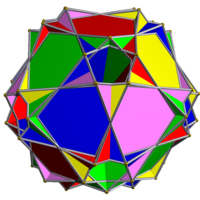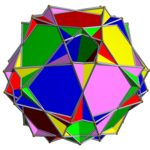| Compound of five octahemioctahedra | |
|---|---|

| |
| Type | Uniform compound |
| Index | UC61 |
| Polyhedra | 5 octahemioctahedra |
| Faces | 40 triangles, 20 hexagons |
| Edges | 120 |
| Vertices | 60 |
| Symmetry group | icosahedral (Ih) |
| Subgroup restricting to one constituent | pyritohedral (Th) |
In geometry, this uniform polyhedron compound is a composition of 5 octahemioctahedra, in the same vertex arrangement as in the compound of 5 cuboctahedra.

